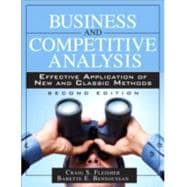
CRAIG S. FLEISHER (Madison, WI) is a pioneering Competitive Intelligence researcher, author, consultant, and professor. He was inaugural chair of the Competitive Intelligence Foundation (CIF); Past President of the Strategic and Competitive Intelligence Professionals, and founding editor of the Journal of Competitive Intelligence and Management. He is now CLO at leading CI consultancy Aurora WDC.
BABETTE BENSOUSSAN (Sydney, Australia) is a global leader in CI, strategy, and marketing who has coached, mentored, and trained executives and organizations throughout the aerospace, telecom, transport, finance, pharmaceutical, and utility industries.
Their books include Strategic and Competitive Analysis and Analysis Without Paralysis.
The New copy of this book will include any supplemental materials advertised. Please check the title of the book to determine if it should include any access cards, study guides, lab manuals, CDs, etc.
The Used, Rental and eBook copies of this book are not guaranteed to include any supplemental materials. Typically, only the book itself is included. This is true even if the title states it includes any access cards, study guides, lab manuals, CDs, etc.